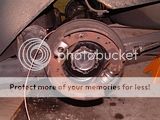CJD
Yoda
Offline
That's funny Randall. I used to have so many arguments with mechanics over that same topic. If I had a nickel for every time I was told "I can turn the impact driver waaaaayyy down"!
 Hi Guest!
Hi Guest!

 smilie in place of the real @
smilie in place of the real @
 Pretty Please - add it to our Events forum(s) and add to the calendar! >> Here's How <<
Pretty Please - add it to our Events forum(s) and add to the calendar! >> Here's How << 
Remove the nut and sand or file just a bit off the back of it. But I have to say that it has never been a problem for me, the nut seems to always line up somewhere between 80 and 100. Don't forget there are two holes through the shaft, so two places where it might line up.What do you suggest to do if the cotter Key does not line up with the hole and it is shimmed and torqued out at 95 pounds?
With the road wheel off and both rear wheels off the ground you push & pull on the hub while having a dial indicator in place against it to measure the float. The specs are in the manual. Float is adjusted by the addition or removal of shims behind the hub

I've never looked, but I don't see why not.1) Are the shims visible between the flange and the back plate?
Yup. Turn the lock tabs (if present) and remove the 6 bolts. The hub & halfshaft should slide right out as an assembly. Try to support it as you do, though, if you think you might reuse the oil seal. The shaft is kind of heavy and not polished.2) Let's say I want to attempt to add shims. That means I'm going to have to add the shims between the axle casing flange and the back plate? From what I've read, it looks like it is possible to remove the entire half shaft without removing the hub.
With a bit of care, you can even leave the brakes connected (if you want). The back plate can hang on the housing, then you can support it slightly away from the housing while installing the shims.The brakes haven't been serviced yet so pulling the brakes, lines, and cables isn't a problem.

Just what I mentioned, try not to drag it through the seal. In fact, if you're not certain the seals were replaced, I'd probably put new ones in. They're cheap, and easy while it's apart; but a giant PITA if they leak later and let the differential oil contaminate the brakes.Then it looks like removing the bolts securing the hub housing to the flange would free up the entire axle for removal. Any "gottchas" in that sequence that I need to be aware of?
I bought a few from TRF, but I'm sure Moss is just as good. Note that the shims are sized so you can make differential adjustments. For example, if you need .002" more, you can take out a .016" and put in (3) .006".3) Any recommended source for shims? I see that Moss lists a couple sizes staring at .004 I think it was.
As always, it's best not to try to reuse the locktabs. So far, Loctite has worked for me, but you can get new tabs from the usual suspects. Don't forget to turn them after you've got it all back together the way you want.Any other thoughts?
Definitely worth checking. But, if you get a different answer, then you're going to have to pull it all apart and rebalance the shim packs. The only way for the measurements to be different is if the thrust block hits the center pin (which it shouldn't). The whole process is covered pretty well in the appendix at the back of the (later edition) workshop manual (or Bentley reprint).A side note to that, once you have done one side, check the other before disassembly, as they are not mutually exclusive measurements.
